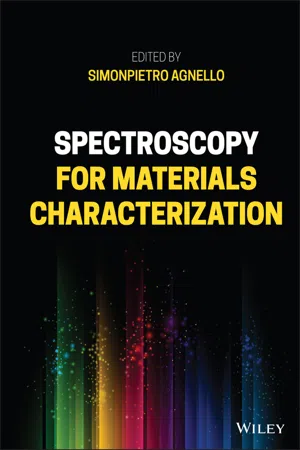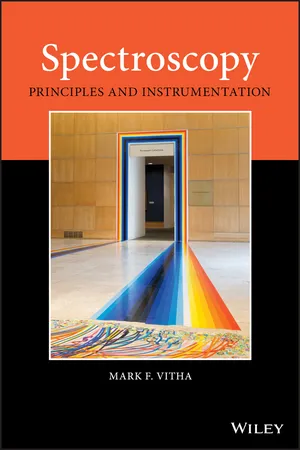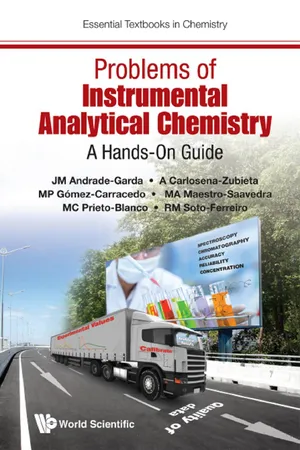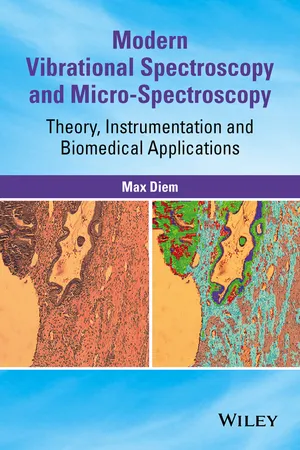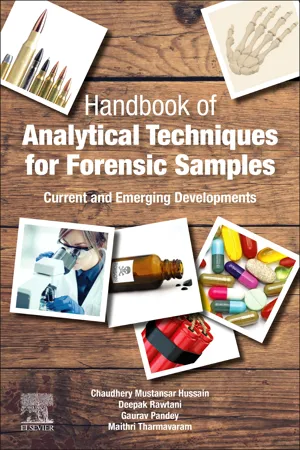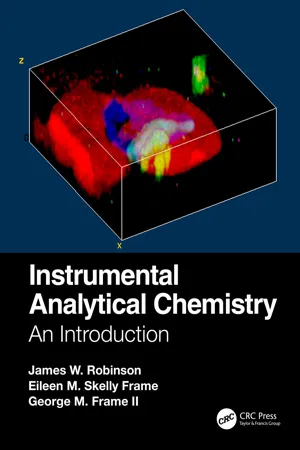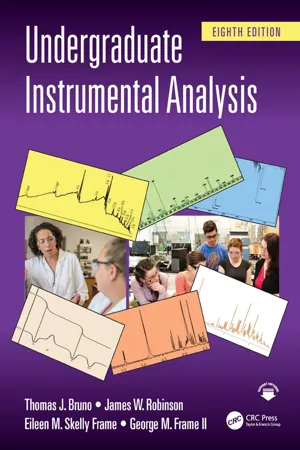Chemistry
Infrared Spectrometer
An infrared spectrometer is a scientific instrument used to analyze the chemical composition of substances by measuring the absorption of infrared radiation. It works by passing infrared light through a sample and detecting the wavelengths that are absorbed. This information can be used to identify functional groups and chemical bonds present in the sample.
Written by Perlego with AI-assistance
Related key terms
Related key terms
1 of 4
Related key terms
1 of 3
10 Key excerpts on "Infrared Spectrometer"
- eBook - ePub
- Simonpietro Agnello(Author)
- 2021(Publication Date)
- Wiley(Publisher)
[1] . The basic components of a dispersive IR spectrometer included a radiation source, monochromator, and detector. This type of instrument helped to spread the use of IR spectroscopy as a common analytical technique for organic compounds characterization in basic and industrial research. However, the development of the Fourier transform infrared (FTIR) spectrometer, and technology advancements in electronics and instruments, marked the abdication of monochromator and the prosperity of interferometer. FTIR instruments employ an interferometer and exploit the well‐established computation of Fourier transformation. FTIR spectroscopic analysis has dramatically improved the quality of the spectra and decreased the time needed to obtain information.IR spectroscopy not only uses the so‐called infrared absorption, but also other techniques such as the attenuated total reflection (ATR) method, diffuse reflectance (DR) method, reflection‐absorption (RA) method, photoacoustic spectroscopy (PAS), and emission spectroscopy. Furthermore, FTIR can be coupled with other analytical techniques (for instance microscopy, thermogravimetric analysis, chromatography, Raman spectroscopy) to retrieve more information about a sample, the so‐called hyphenated techniques.5.1.1 Introduction
IR spectroscopy is a technique based on the vibrations of the atoms of a molecule. Sample molecules with covalent bonds absorb radiation of specific wavelengths when a bond in the molecule vibrates at the same frequency as the incident radiant energy. Consequently, the vibrational energy levels of sample molecules transfer from ground state to excited state. The frequency absorbed depends on many factors such as the strength of the bond, the masses of the bond atoms, the chemical bonds within the molecule, and the geometry of the molecule. Molecular vibrations therefore readily reflect chemical features of a molecule and, as a result, IR spectroscopy contributes to the study of the molecule structure. This chapter covers both the basic theory of FTIR and how FTIR spectrometers work as well as discussing some of the practical aspects of FTIR use. - eBook - ePub
Spectroscopy
Principles and Instrumentation
- Mark F. Vitha(Author)
- 2018(Publication Date)
- Wiley(Publisher)
4 INFRARED SPECTROSCOPYThis chapter continues our discussion of the analytical uses of spectroscopy that started with the chapter on the fundamental characteristics of electromagnetic radiation (EMR) and continued into the chapters about UV‐visible and fluorescence spectroscopy. Here we focus on the infrared (IR) region of the spectrum. Two of the most common tasks for chemists are verifying the structure of reaction products and determining the identity of unknown compounds. IR spectroscopy provides information about the functional groups present in molecules by probing the nature of the vibrational energy of bonds. It is therefore frequently used to assist in structure elucidation. Because of its use in structural analysis, IR spectroscopy is generally associated with qualitative analyses, but it is also used for quantitative analyses, with recent advances in instrumentation expanding such uses.In the sections below, we- Discuss the fundamental bond vibrations upon which IR spectroscopy is based and the theories used to explain why different bonds vibrate with different frequencies.
- Describe the instrumentation designed to measure the absorption of IR radiation and how we gain chemical information from such measurements.
- Explain a variety of sampling methods for analyzing solids, liquids, and gases.
- Examine a number of important applications that illustrate how the entire IR region of the spectrum, including the near‐, mid‐, and far‐IR regions, are used in quantitative and qualitative chemical analyses.
4.1. THEORY
In the UV‐visible spectroscopy chapter, we saw that molecules absorb electromagnetic radiation when the energy of the radiation matches a ground to excited state electronic transition in the molecule. The amount of light absorbed, A, is given by(4.1)where Po is the power of radiation transmitted to the detector when a reference is present and P is power transmitted to the detector when the sample is present. The transmittance, T, is equal to P/Po , and is the fraction of light transmitted through the sample. This relationship is also true in IR spectroscopy. However, the fundamental molecular change that causes the absorption of radiation is different. UV‐visible spectroscopy probes electronic transitions, while IR spectroscopy probes the vibrational motions of bonds in a molecule. A typical IR spectrum is shown in Figure 4.1 . Each of the peaks arises from bond vibrations. Infrared spectra such as the one in this figure for a wide range of compounds can be found in Ref. [1] - eBook - ePub
Practical Guide to Materials Characterization
Techniques and Applications
- Khalid Sultan(Author)
- 2022(Publication Date)
- Wiley-VCH(Publisher)
8 Infrared Spectroscopy8.1 Introduction
The study of spectroscopy is the study of matter’s interaction with electromagnetic radiations. Depending on the electromagnetic waves used for generations and the relative detector used, a variety of spectroscopy techniques have been developed for different applications in a material research. A few examples of electromagnetic waves typically used include X-rays, UV-Vis (ultraviolet-visible), IR (including near IR, mid- and far infrared), and microwave. Depending on how the electromagnetic wave interacts with the sample, different instruments are used. EDX (energy-dispersive X-ray spectroscopy) analyzes the X-ray spectrum generated by the sample when it is excited by an electron beam or an X-ray beam. XRD (X-ray diffraction crystallography) characterizes the angle of diffraction that the sample produces when an X-ray is incident. UV-Vis and Fourier transform infrared (FTIR) spectroscopy analyze the absorption spectrum.In many aspects, a UV-Vis spectrometer is comparable to an IR spectrometer. They are both used to examine the matter’s absorption. Second, their instrumentation is comparable. A light source, a sample chamber, and a detector make up the basic setup. The wavelength selection portion, often known as the monochromator, is crucial. Because the detector can only respond to the whole intensity of the input light, the incident wave must be separated into multiple wavelengths. Both UV-Vis and IR spectrometers initially used a diffraction grating as a monochromator. The diffraction grating is accompanied by a motor to move the scattered spectrum and a slit to choose a wavelength of a specified bandwidth with a single detector. The dimension of the the slit decides the resolution. The compact UV-Vis spectrometers adopted a diode array or linear CCD (charged coupled device) as the detector, allowing, simultaneously, for a whole spectrum. - eBook - ePub
Problems of Instrumental Analytical Chemistry
A Hands-On Guide
- JM Andrade-Garda, A Carlosena-Zubieta;MP Gómez-Carracedo;MA Maestro-Saavedra;MC Prieto-BlancoRM Soto-Ferreiro(Authors)
- 2017(Publication Date)
- WSPC (EUROPE)(Publisher)
CHAPTER 4
INFRARED SPECTROMETRY
José Manuel Andrade-Garda andMaría Paz Gómez-Carracedo
OBJECTIVES AND SCOPE
The objective of this chapter is to present students the very basics of the chemical interpretation of an infrared (IR) spectrum. Explanations will be restricted to typical functional groups and relatively simple structures. Also, only the medium IR region and organic molecules will be considered. Quantitation issues are commented briefly since the multivariate statistical treatment is out of the scope of this book and classical calibration will be treated deeply in the other chapters. Therefore, the chapter focuses on the basics of IR spectra interpretation, something that somehow is not considered in many textbooks in analytical chemistry.1.INTRODUCTION
1.1.Basic concepts
Infrared (IR) spectrometry (or spectrometry in the infrared region, IR) is a molecular analysis technique of paramount importance in chemistry. Not in vain it is a powerful, ubiquitous workhorse to study and ascertain the main characteristics of molecular structures. Further, and in addition to this classical application, its use has fostered in the last two decades, thanks to its combination with multivariate chemometric techniques (mainly full-spectrum regression techniques like partial least squares, PLS). This conferred on IR spectrometry an unprecedent power to quantitate one or several species of interest in the analyzed aliquots. In conjunction with nuclear magnetic resonance (NMR) and mass spectrometry (MS), it constitutes a basic tool for most studies on organic and inorganic materials performed nowadays.Frequently, references to the ‘infrared region’ assume implicitly that work is performed at the medium IR range (MIR or mid-IR, 4000–600 cm−1 ), which is considered to offer a spectral ‘fingerprint’ of a substance [1 , 2 ]. However, nowadays the near infrared range (NIR, 13300–4000 cm−1 ) has become a very powerful and popular tool. The NIR range is used to study, mainly, harmonic vibrations of the functional groups. Practical applications using the far infrared region (FIR, 400–20 cm−1 ) are still pretty scarce, although they are increasing, thanks to the so-called terahertz spectroscopy [3 ], a term which somehow supersedes the FIR one. A relevant advantage of this region is that plastics, cloth and semiconducting materials are transparent, opening up ways to in situ - eBook - ePub
Modern Vibrational Spectroscopy and Micro-Spectroscopy
Theory, Instrumentation and Biomedical Applications
- Max Diem(Author)
- 2015(Publication Date)
- Wiley(Publisher)
Chapter 3 Infrared SpectroscopyIn this and the following chapter, the two main modalities for observing molecular vibrational spectra are discussed, starting with infrared (IR) spectroscopy. This field started in the late 1930s, using mostly home-built instruments that incorporated prism monochromators and thermocouple detectors and the most basic electronic amplification circuitry, because solid-state (or even digital) electronics was still decades in the future. Nevertheless, the value of IR spectroscopy as a qualitative structural tool was soon realized, and the methodology soon migrated from physics laboratories, where it was originally developed, into chemical laboratories, both in academe and industry, and soon became one of the first physical methods to aid in structure determination. Except for very high resolution studies and astrophysical applications, IR spectroscopy is now being used and developed largely in physical chemistry research, since this technique offers a phenomenally sensitive probe for molecular structure, conformation, interactions, and dynamics.The basic concepts of the theory of IR spectroscopy were introduced in Sections 1.2 –1.5 , and fundamental aspects of the observation of the effect were discussed in Section 1.6 . The selection rules based on molecular symmetry were introduced in Chapter 2 , and a few IR absorption spectra of small molecules were shown in Section 2.6 . In the following sections, basic optical concepts of the interaction of IR radiation with molecular samples are introduced, followed by a discussion of instrumentation for the observation of IR spectra. Finally, data collection strategies (i.e., transmission, reflection, attenuated total reflection (ATR), etc.) are discussed.3.1 General aspects of IR spectroscopy
IR spectra can be observed using several sampling methods and geometries that will be discussed in turn. However, in the most basic form of this technique, an IR photon is absorbed by the sample, causing excitation of one normal mode of vibration into a higher vibrational energy level. As pointed out earlier, such a process can be described by Eq. 1.114 , which states that the quantum mechanical transition moment determines the molar extinction coefficient - eBook - ePub
- David G. Watson(Author)
- 2020(Publication Date)
- Elsevier(Publisher)
5: Infrared spectrophotometry
- Introduction,
-
Factors determining intensity and energy level of absorption in IR spectra,
- Intensity of absorption,
- Energy level of absorption,
-
Instrumentation,
- Instrument calibration,
- Sample preparation,
- Application of IR spectrophotometry in structure elucidation,
- Examples of IR spectra of drug molecules,
-
IR spectrophotometry as a fingerprint technique,
- Preparation of samples for fingerprint determination,
- IR spectrophotometry as a method for identifying polymorphs,
- Near-infrared analysis (NIRA),
- Introduction,
-
Examples of NIRA applications,
- Determination of particle size in United States Pharmacopoeia (USP) grade aspirin,
- Determination of blend uniformity,
- Determination of active ingredients in multicomponent dosage forms,
- In-pack determination of active ingredients,
- Determination of polymorphs,
- Moisture determination,
- Process control of components in a shampoo,
KeypointsPrinciples-
• Electromagnetic radiation ranging between 400 cm− 1and 4000 cm−
- eBook - ePub
Handbook of Analytical Techniques for Forensic Samples
Current and Emerging Developments
- Deepak Rawtani, Gaurav Pandey, Maithri Tharmavaram, Chaudhery Mustansar Hussain(Authors)
- 2020(Publication Date)
- Elsevier(Publisher)
Infrared spectroscopy is a type of vibrational spectroscopy in which the energy of the incident electromagnetic radiation is absorbed by the molecule, gets excited, and then undergoes rotations or vibrations. Infrared spectroscopy is a widely used technique because of its versatility and rapid results. A myriad of liquids, solids, and gaseous samples can be easily analyzed using this technique. It also requires minimal sample preparation and based on the type of technique used, it can also be nondestructive in nature.This technique involves the use of infrared rays, and the amount of rays absorbed by the sample is taken into account. The principle and theory behind this technique will be discussed further in this chapter. While IR spectroscopy takes into account the vibrational energy of the molecules, another technique known as near-infrared takes into account both the electronic and vibrational transitions. This makes NIR a very unique technique capable of analyzing a wide range of molecules. The IR region lies between 700 nm and 1 mm while NIR lies between 800 nm and 1.2 mm.Quite often, samples are analyzed through an amalgamation of Raman, near-infrared, and IR spectroscopy in order to get a comprehensive idea about the compound. Forensic science extensively uses these techniques to analyze samples such as paints, explosives, drugs, and counterfeit compounds (Pandey et al., 2017 ; Rawtani et al., 2019 ). Because these techniques are nondestructive and reliable, they are capable of analyzing the samples. In this chapter, the use of IR and NIR in the analysis of biological samples, inks, questionable documents, explosives, gunshot residue, illicit and counterfeit drugs, bank notes, and paint is discussed. Also, the principle, theory, and instrumentation of the techniques are given.2: Principle and theory of infrared and near-infrared spectroscopy
2.1: Principle of infrared spectroscopy
Infrared spectroscopy, just like any other spectroscopy technique, is based on the use of electromagnetic radiation to analyze compounds. Electromagnetic radiation consists of an electric and magnetic component that are perpendicularly aligned with each other and travel in a sinusoidal manner. As mentioned before, IR spectroscopy is based on the absorption of the IR by the sample, due to which it gets excited and starts to vibrate. The vibrational signal sent out is characteristic of each molecule and thus serves as the basis of this spectroscopy. - Yin Sun, Kwok Y. Ong(Authors)
- 2004(Publication Date)
- CRC Press(Publisher)
There are two major types of IR instruments: one type detects IR emitted from objects, such as IR cameras; and the other detects IR radiation absorbed by objects, such as IR spectroscopy. The uses of the IR technique in the analytical and detection field are based on IR absorption characteristics at specific wavelengths by the substances of interest.Function groups in a molecule vibrate at certain frequencies that fall within the IR region. The molecule absorbs energy from IR waves that have the same frequencies, as the vibrating function groups are excited to a higher energy level. Specific function groups absorb IR radiation having specific frequencies. By determining the IR radiation frequencies being absorbed by the function groups composing the molecule, the molecular structure can be determined. The spectrum of a large molecule can be very complex, depending on the number of function groups in the molecule. Therefore, large IR spectra databases have been established for many chemicals. For example, the National Institute of Standards and Technology has a database comprised of 5228 infrared spectra. The identification of a substance and its structure can be determined through matching its IR absorption spectrum with spectra from the databases.A simplified method is generally used for detecting certain groups of chemicals in a vapor sample. For field applications of CWA and TIC detection, the objective of course is to determine whether the sample contains the targeted chemical(s) rather than identifying the structure of these chemicals. The characteristic frequencies of targeted chemicals are known based on their function groups and confirmed in laboratory studies. Therefore, it may suffice to check the IR absorption using a few characteristic wavelengths to achieve the detection objective. This can be done by exposing the sample to IR radiation at several selected wavelengths that are characteristically absorbed by the targeted chemicals. This greatly simplifies the instrumentation design of IR detectors. We will focus on detection aspects rather than structure identification using various IR technologies.- eBook - ePub
Instrumental Analytical Chemistry
An Introduction
- James W. Robinson, Eileen M. Skelly Frame, George M. Frame II(Authors)
- 2021(Publication Date)
- CRC Press(Publisher)
4.53 .Figure 4.52The Raman and FTIR spectra of a 10 μm fiber of a nylon 6-polyethylene glycol block copolymer. Spectra were collected at exactly the same spot on the fiber. FTIR spectrum is at the top; Raman spectrum at the bottom. (Courtesy of ©HORIBA Scientific, www.horiba.com .)Figure 4.53Raman and FTIR spectra of a gallstone. The spectra were recorded with the LabRAM-IR microscope using a 532 nm laser. The FTIR spectrum is more sensitive to the OH bands, while the Raman spectrum starts below 600 cm−1 and shows details of the cholesteric species and the c=c bands. (Courtesy of ©HORIBA Scientific, www.horiba.com .)4.9 Chemical Imaging Using NIR, IR, and Raman Spectroscopy
The most recent breakthrough in the use of vibrational spectroscopy for chemical analysis is in the area of chemical imaging. Chemical imaging is the use of 2D or 3D detectors to collect spectral data from a large number of locations within a sample and then using the variations in the spectral data to map chemical differences within the sample. The chemical differences are often displayed as a false-color image of the sample, called a chemigram.FTIR imaging has been commercially available since 1996. The usual “detector” is an MCT array detector, called a focal plane array (FPA ) detector, used in conjunction with an FTIR microscope. A 64 × 64 FPA detector has 4096 detector elements and allows 4096 interferograms to be collected simultaneously. Because each pixel in the detector array generates a spectrum, there are three dimensions in the data set. These data sets are often referred to as data cubes or image cubes. The x and y coordinates of the cube are the spatial positions while the z - eBook - ePub
- Thomas J. Bruno, James W. Robinson, George M. Frame II, Eileen M. Skelly Frame(Authors)
- 2023(Publication Date)
- CRC Press(Publisher)
.77 .Figure 5.76Raman and FTIR spectra of a 10 μm fiber of a nylon 6-PEG block copolymer. Spectra were collected at exactly the same spot on the fiber. (Courtesy of HORIBA Scientific, www.horiba.com .)Figure 5.77Raman and FTIR spectra of a gallstone. The spectra were recorded with the LabRAM-IR microscope using a 532 nm laser. The FTIR spectrum is more sensitive to the OH bands, while the Raman spectrum starts below 600 cm−1 and shows details of the cholesteric species and the C=C bands. (Courtesy of HORIBA Scientific, www.horiba.com .)5.9 CHEMICAL IMAGING USING NIR, IR, AND RAMAN SPECTROSCOPY
The most recent breakthrough in the use of vibrational spectroscopy for chemical analysis is in the area of chemical imaging. Chemical imaging is the use of 2D or 3D detectors to collect spectral data from a large number of locations within a sample and then using the variations in the spectral data to map chemical differences within the sample. The chemical differences are often displayed as a false-color image of the sample, called a chemigram. The use of chemical imaging technology in NMR has been described in Chapter 6 ; it is the technique more commonly called magnetic resonance imaging (MRI).FTIR imaging has been commercially available since 1996. The usual “detector” is an MCT array detector, called a focal plane array (FPA) detector, used in conjunction with an FTIR microscope. A 64 × 64 FPA detector has 4096 detector elements and allows 4096 interferograms to be collected simultaneously. Because each pixel in the detector array generates a spectrum, there are three dimensions in the data set. These data sets are often referred to as data cubes or image cubes. The x and y coordinates of the cube are the spatial positions while the z coordinate represents the wavelength, as shown in Figure 5.78 . The data can be handled in many ways, including the use of library searching, principal component analysis, and more, making this a powerful technique. Principal component analysis is a technique that sorts the image spectra into an independent set of subspectra (the principal components) from which the image spectra can be reconstructed. If there are five layers in a polymer laminate, for example, and there are 1000 image spectra, in theory, five subspectra would be sufficient to describe all 1000 image spectra. In practice, more than five subspectra are needed, due to variations in baseline, instrumental conditions, impurities, and so on. The amounts of the principal components in the original image are calculated at each pixel and the resulting scores are used to enhance the IR image contrast. See the reference by Sellors for more detail and color images that cannot be easily reproduced in gray scale, as well as the websites of the major instrument companies for full-color application notes. As a simple example, the intensity of the carbonyl-stretching band in each pixel can be “reassembled” into the visual image seen through the microscope, giving a distribution of carbonyl-containing material in the sample. Such an image is shown in Figure 5.79 , collected with a Spectrum Spotlight FTIR Imaging System (www.perkinelmer.com
Index pages curate the most relevant extracts from our library of academic textbooks. They’ve been created using an in-house natural language model (NLM), each adding context and meaning to key research topics.
Explore more topic indexes
Explore more topic indexes
1 of 6
Explore more topic indexes
1 of 4
